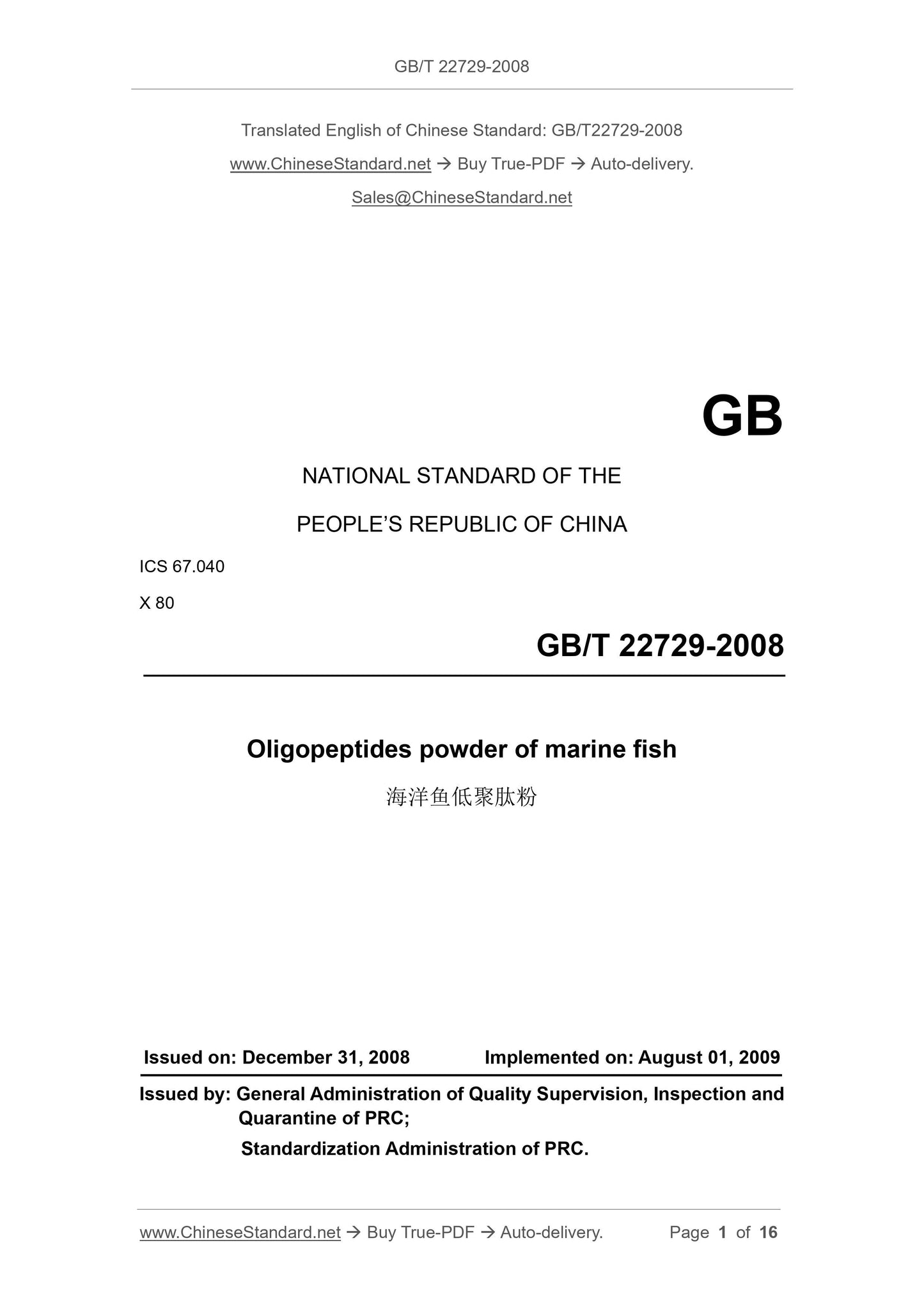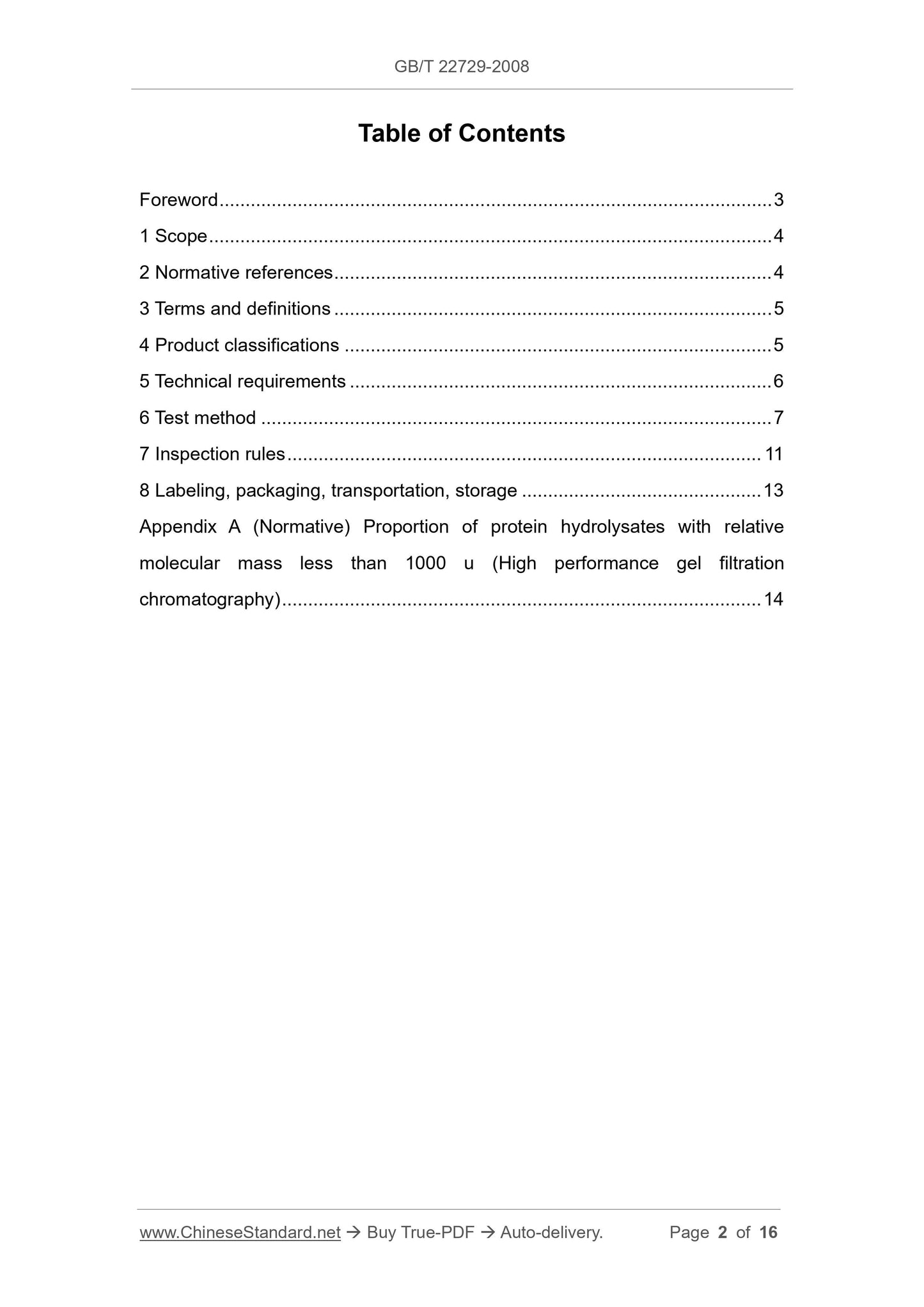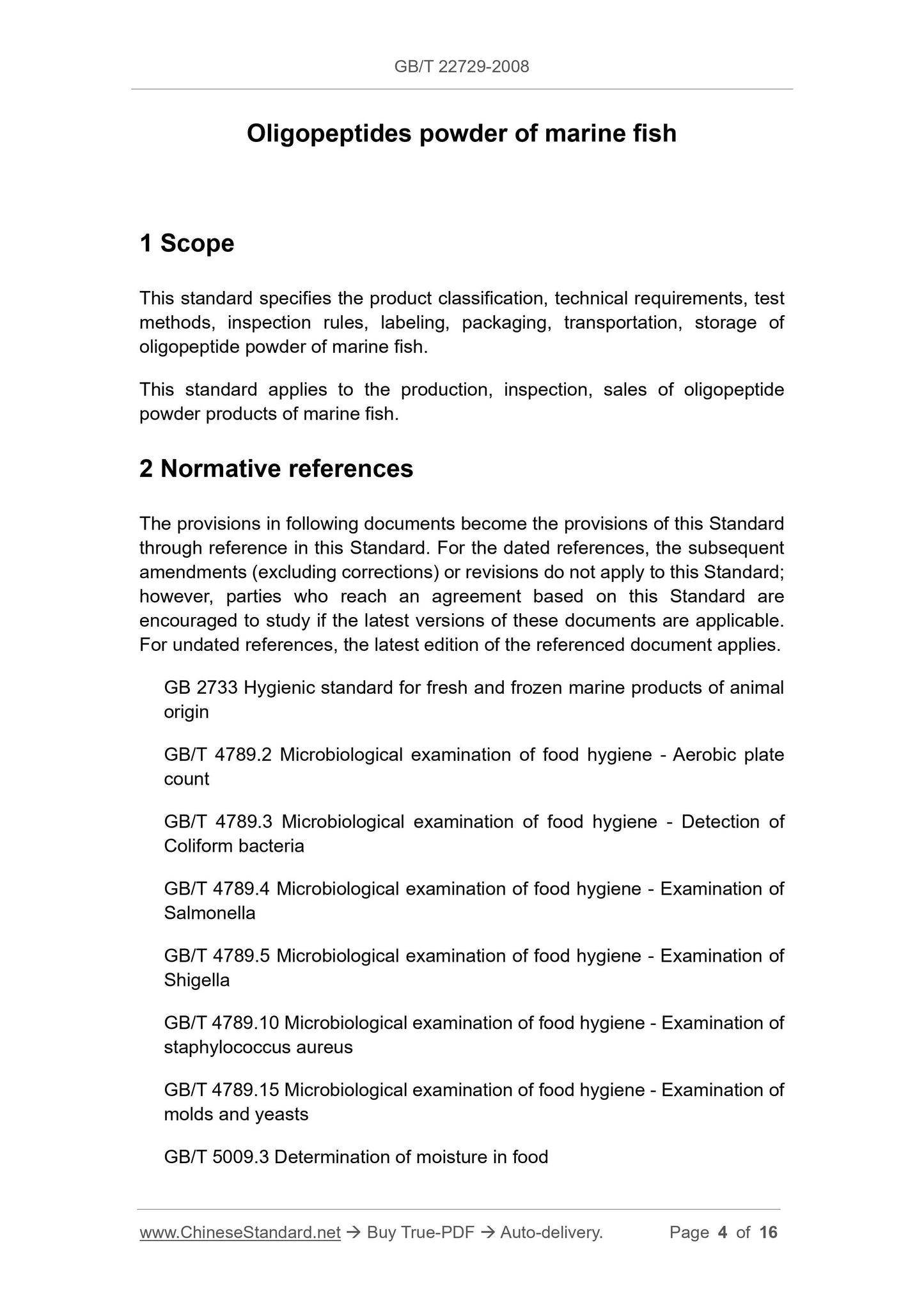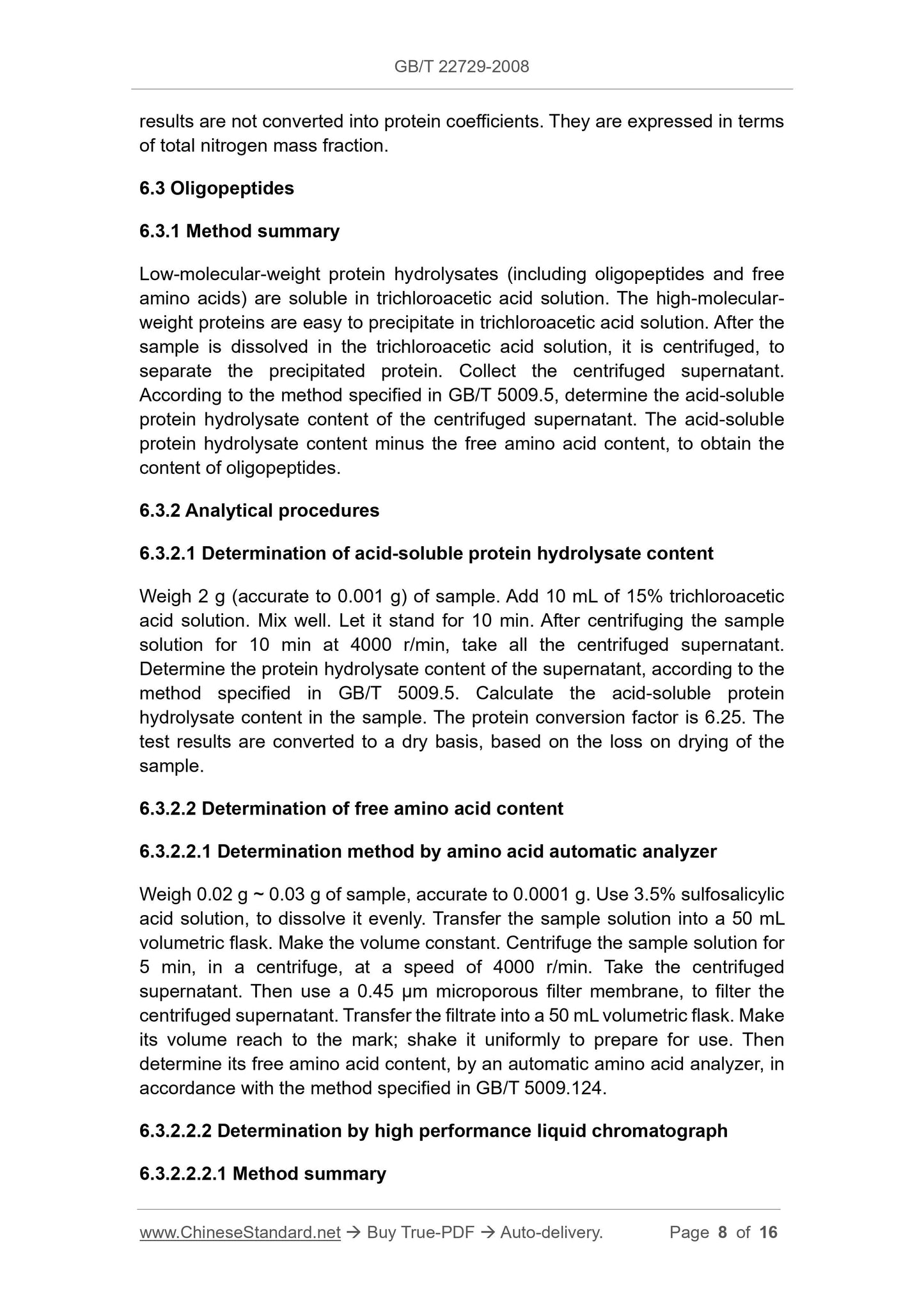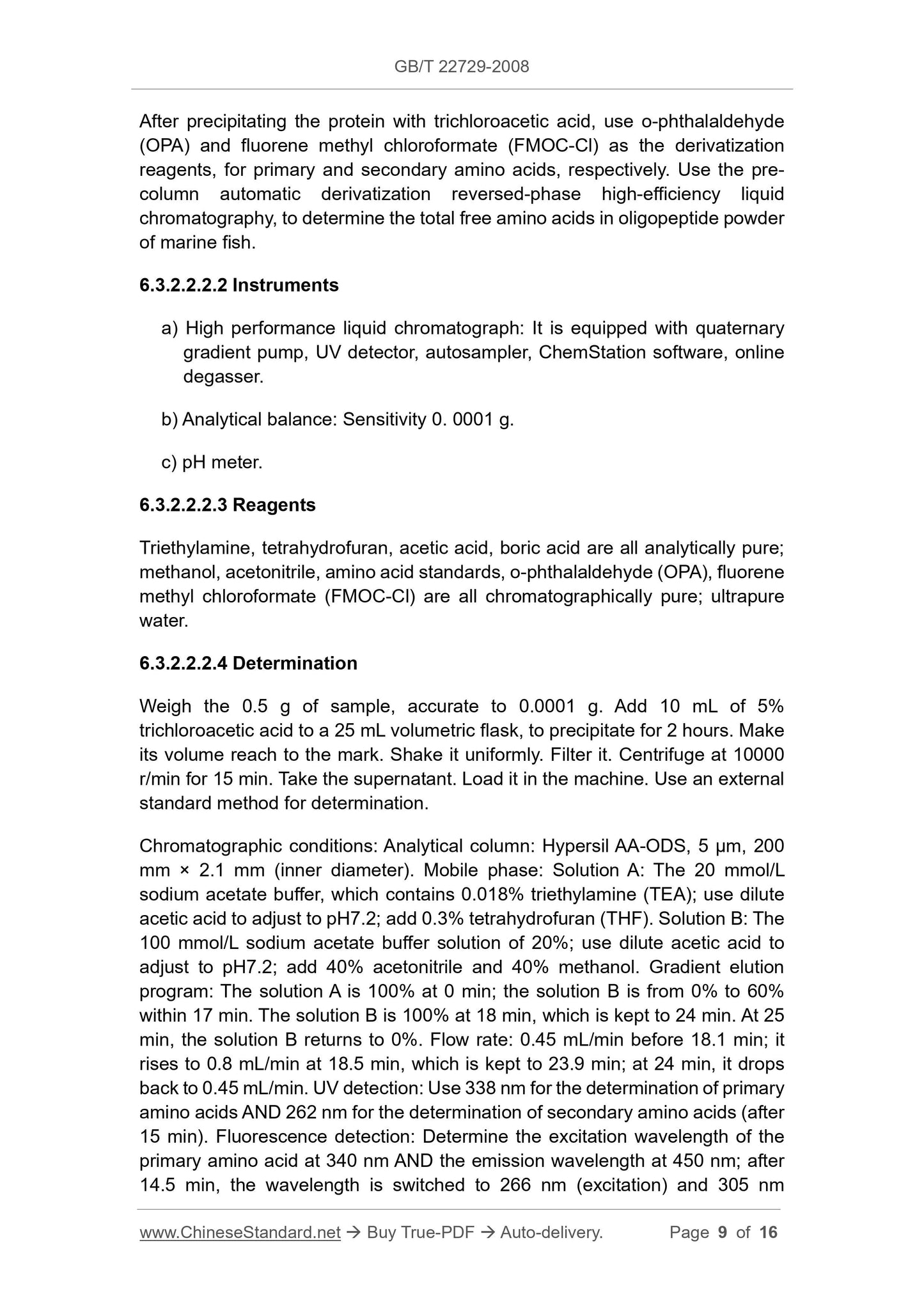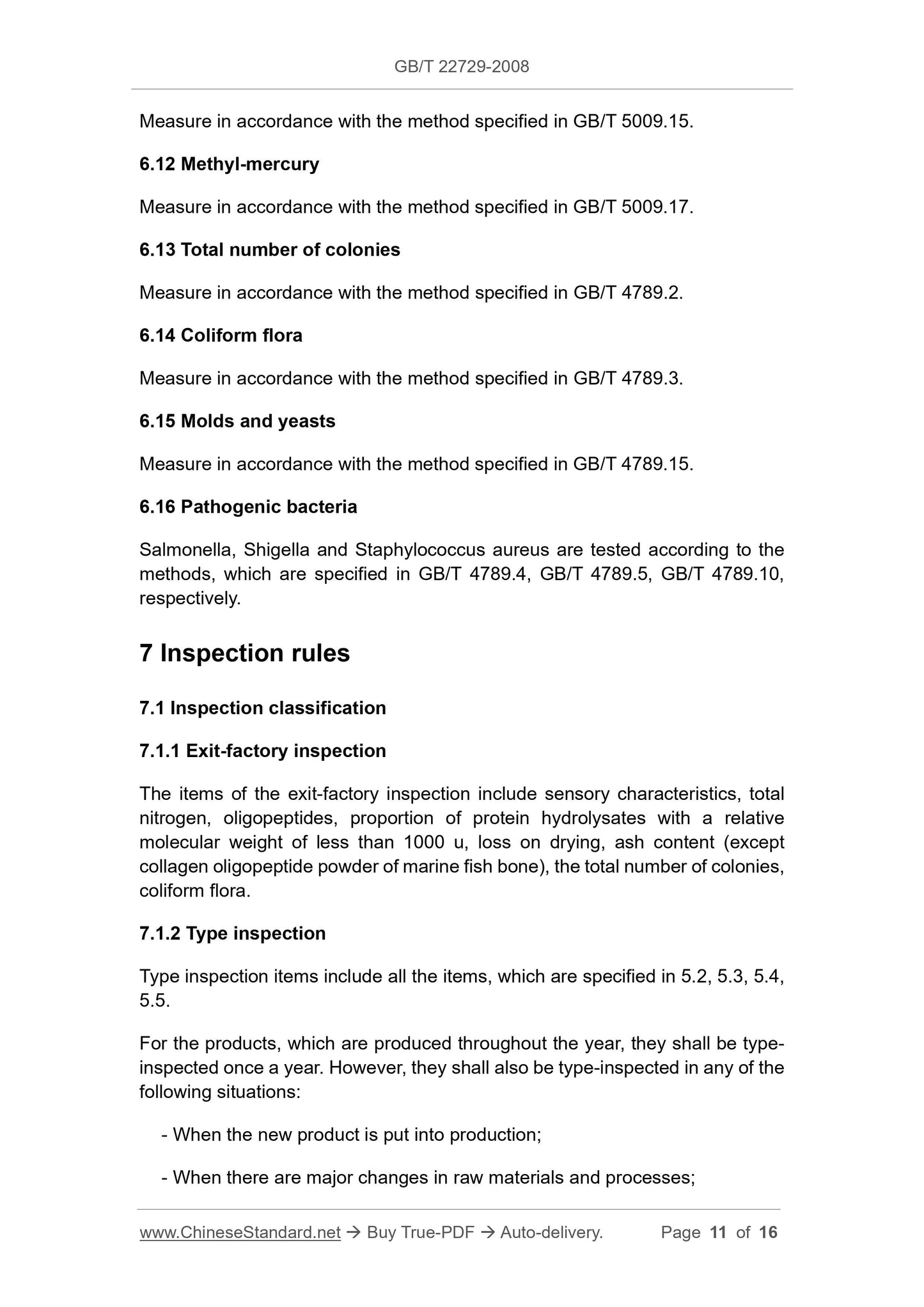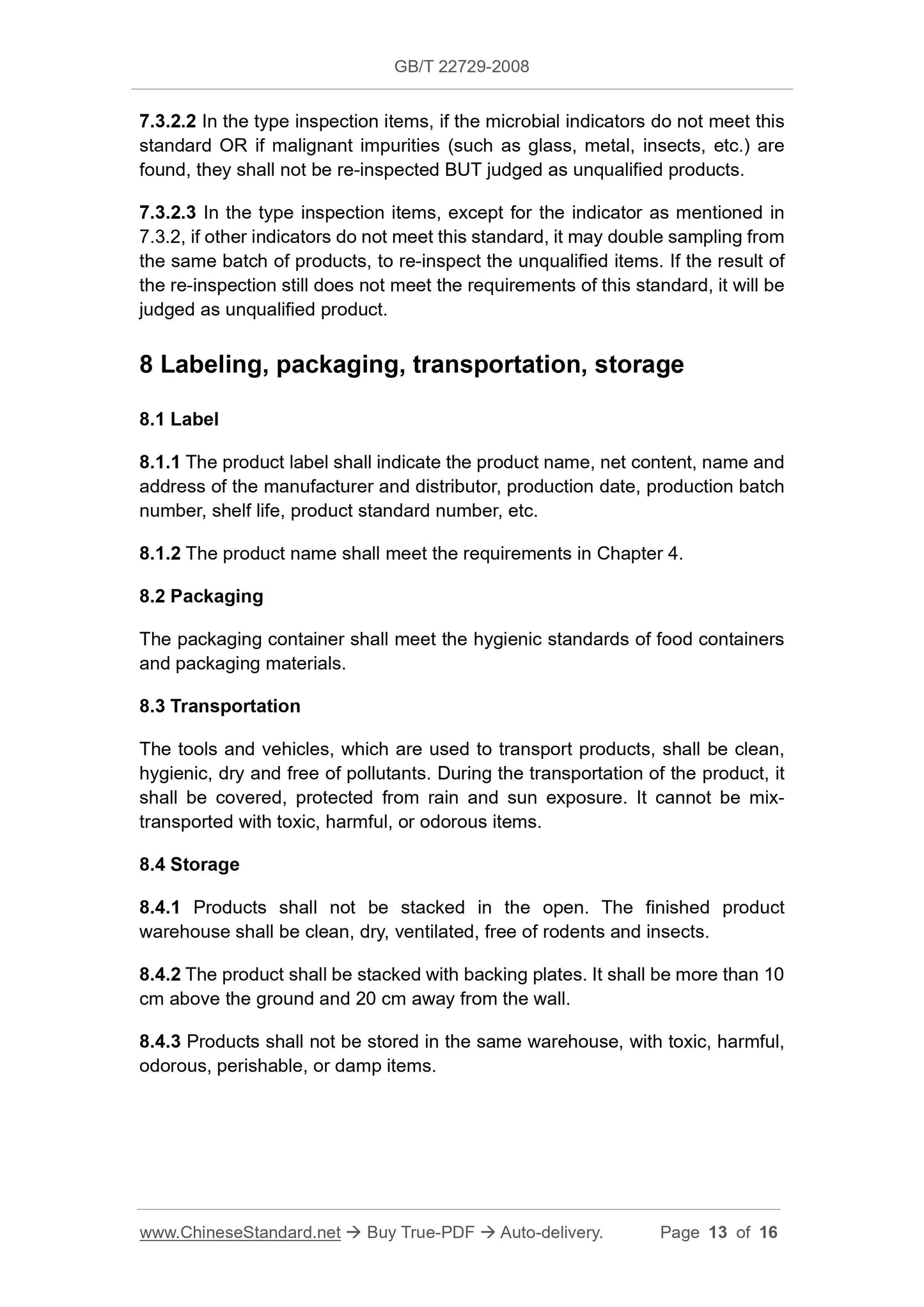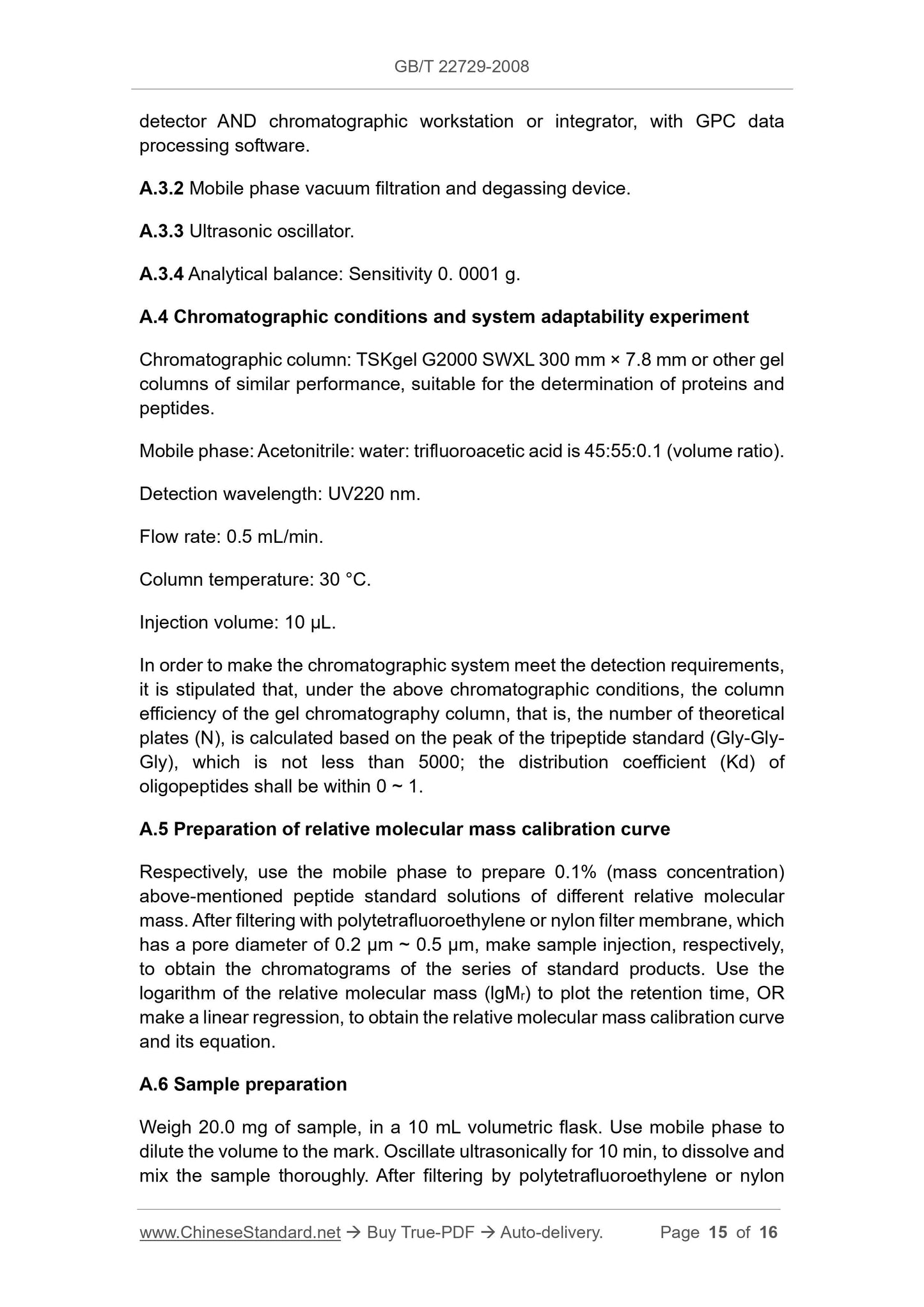1
/
de
8
PayPal, credit cards. Download editable-PDF and invoice in 1 second!
GB/T 22729-2008 English PDF (GBT22729-2008)
GB/T 22729-2008 English PDF (GBT22729-2008)
Prix habituel
$160.00 USD
Prix habituel
Prix promotionnel
$160.00 USD
Prix unitaire
/
par
Frais d'expédition calculés à l'étape de paiement.
Impossible de charger la disponibilité du service de retrait
Delivery: 3 seconds. Download true-PDF + Invoice.
Get QUOTATION in 1-minute: Click GB/T 22729-2008
Historical versions: GB/T 22729-2008
Preview True-PDF (Reload/Scroll if blank)
GB/T 22729-2008: Oligopeptides powder of marine fish
GB/T 22729-2008
GB
NATIONAL STANDARD OF THE
PEOPLE’S REPUBLIC OF CHINA
ICS 67.040
X 80
Oligopeptides powder of marine fish
海洋鱼低聚肽粉
ISSUED ON: DECEMBER 31, 2008
IMPLEMENTED ON: AUGUST 01, 2009
Issued by: General Administration of Quality Supervision, Inspection and
Quarantine of PRC;
Standardization Administration of PRC.
Table of Contents
Foreword ... 3
1 Scope ... 4
2 Normative references ... 4
3 Terms and definitions ... 5
4 Product classifications ... 5
5 Technical requirements ... 6
6 Test method ... 7
7 Inspection rules ... 11
8 Labeling, packaging, transportation, storage ... 13
Appendix A (Normative) Proportion of protein hydrolysates with relative
molecular mass less than 1000 u (High performance gel filtration
chromatography) ... 14
Oligopeptides powder of marine fish
1 Scope
This standard specifies the product classification, technical requirements, test
methods, inspection rules, labeling, packaging, transportation, storage of
oligopeptide powder of marine fish.
This standard applies to the production, inspection, sales of oligopeptide
powder products of marine fish.
2 Normative references
The provisions in following documents become the provisions of this Standard
through reference in this Standard. For the dated references, the subsequent
amendments (excluding corrections) or revisions do not apply to this Standard;
however, parties who reach an agreement based on this Standard are
encouraged to study if the latest versions of these documents are applicable.
For undated references, the latest edition of the referenced document applies.
GB 2733 Hygienic standard for fresh and frozen marine products of animal
origin
GB/T 4789.2 Microbiological examination of food hygiene - Aerobic plate
count
GB/T 4789.3 Microbiological examination of food hygiene - Detection of
Coliform bacteria
GB/T 4789.4 Microbiological examination of food hygiene - Examination of
Salmonella
GB/T 4789.5 Microbiological examination of food hygiene - Examination of
Shigella
GB/T 4789.10 Microbiological examination of food hygiene - Examination of
staphylococcus aureus
GB/T 4789.15 Microbiological examination of food hygiene - Examination of
molds and yeasts
GB/T 5009.3 Determination of moisture in food
results are not converted into protein coefficients. They are expressed in terms
of total nitrogen mass fraction.
6.3 Oligopeptides
6.3.1 Method summary
Low-molecular-weight protein hydrolysates (including oligopeptides and free
amino acids) are soluble in trichloroacetic acid solution. The high-molecular-
weight proteins are easy to precipitate in trichloroacetic acid solution. After the
sample is dissolved in the trichloroacetic acid solution, it is centrifuged, to
separate the precipitated protein. Collect the centrifuged supernatant.
According to the method specified in GB/T 5009.5, determine the acid-soluble
protein hydrolysate content of the centrifuged supernatant. The acid-soluble
protein hydrolysate content minus the free amino acid content, to obtain the
content of oligopeptides.
6.3.2 Analytical procedures
6.3.2.1 Determination of acid-soluble protein hydrolysate content
Weigh 2 g (accurate to 0.001 g) of sample. Add 10 mL of 15% trichloroacetic
acid solution. Mix well. Let it stand for 10 min. After centrifuging the sample
solution for 10 min at 4000 r/min, take all the centrifuged supernatant.
Determine the protein hydrolysate content of the supernatant, according to the
method specified in GB/T 5009.5. Calculate the acid-soluble protein
hydrolysate content in the sample. The protein conversion factor is 6.25. The
test results are converted to a dry basis, based on the loss on drying of the
sample.
6.3.2.2 Determination of free amino acid content
6.3.2.2.1 Determination method by amino acid automatic analyzer
Weigh 0.02 g ~ 0.03 g of sample, accurate to 0.0001 g. Use 3.5% sulfosalicylic
acid solution, to dissolve it evenly. Transfer the sample solution into a 50 mL
volumetric flask. Make the volume constant. Centrifuge the sample solution for
5 min, in a centrifuge, at a speed of 4000 r/min. Take the centrifuged
supernatant. Then use a 0.45 μm microporous filter membrane, to filter the
centrifuged supernatant. Transfer the filtrate into a 50 mL volumetric flask. Make
its volume reach to the mark; shake it uniformly to prepare for use. Then
determine its free amino acid content, by an automatic amino acid analyzer, in
accordance with the method specified in GB/T 5009.124.
6.3.2.2.2 Determination by high performance liquid chromatograph
6.3.2.2.2.1 Method summary
After precipitating the protein with trichloroacetic acid, use o-phthalaldehyde
(OPA) and fluorene methyl chloroformate (FMOC-Cl) as the derivatization
reagents, for primary and secondary amino acids, respectively. Use the pre-
column automatic derivatization reversed-phase high-efficiency liquid
chromatography, to determine the total free amino acids in oligopeptide powder
of marine fish.
6.3.2.2.2.2 Instruments
a) High performance liquid chromatograph: It is equipped with quaternary
gradient pump, UV detector, autosampler, ChemStation software, online
degasser.
b) Analytical balance: Sensitivity 0. 0001 g.
c) pH meter.
6.3.2.2.2.3 Reagents
Triethylamine, tetrahydrofuran, acetic acid, boric acid are all analytically pure;
methanol, acetonitrile, amino acid standards, o-phthalaldehyde (OPA), fluorene
methyl chloroformate (FMOC-Cl) are all chromatographically pure; ultrapure
water.
6.3.2.2.2.4 Determination
Weigh the 0.5 g of sample, accurate to 0.0001 g. Add 10 mL of 5%
trichloroacetic acid to a 25 mL volumetric flask, to precipitate for 2 hours. Make
its volume reach to the mark. Shake it uniformly. Filter it. Centrifuge at 10000
r/min for 15 min. Take the supernatant. Load it in the machine. Use an external
standard method for determination.
Chromatographic conditions: Analytical column: Hypersil AA-ODS, 5 μm, 200
mm × 2.1 mm (inner diameter). Mobile phase: Solution A: The 20 mmol/L
sodium acetate buffer, which contains 0.018% triethylamine (TEA); use dilute
acetic acid to adjust to pH7.2; add 0.3% tetrahydrofuran (THF). Solution B: The
100 mmol/L sodium acetate buffer solution of 20%; use dilute acetic acid to
adjust to pH7.2; add 40% acetonitrile and 40% methanol. Gradient elution
program: The solution A is 100% at 0 min; the solution B is from 0% to 60%
within 17 min. The solution B is 100% at 18 min, which is kept to 24 min. At 25
min, the solution B returns to 0%. Flow rate: 0.45 mL/min before 18.1 min; it
rises to 0.8 mL/min at 18.5 min, which is kept to 23.9 min; at 24 min, it drops
back to 0.45 mL/min. UV detection: Use 338 nm for the determination of primary
amino acids AND 262 nm for the determination of secondary amino acids (after
15 min). Fluorescence detection: Determine the excitation wavelength of the
primary amino acid at 340 nm AND the emission wavelength at 450 nm; after
14.5 min, the wavelength is switched to 266 nm (excitation) and 305 nm
Measure in accordance with the method specified in GB/T 5009.15.
6.12 Methyl-mercury
Measure in accordance with the method specified in GB/T 5009.17.
6.13 Total number of colonies
Measure in accordance with the method specified in GB/T 4789.2.
6.14 Coliform flora
Measure in accordance with the method specified in GB/T 4789.3.
6.15 Molds and yeasts
Measure in acco...
Get QUOTATION in 1-minute: Click GB/T 22729-2008
Historical versions: GB/T 22729-2008
Preview True-PDF (Reload/Scroll if blank)
GB/T 22729-2008: Oligopeptides powder of marine fish
GB/T 22729-2008
GB
NATIONAL STANDARD OF THE
PEOPLE’S REPUBLIC OF CHINA
ICS 67.040
X 80
Oligopeptides powder of marine fish
海洋鱼低聚肽粉
ISSUED ON: DECEMBER 31, 2008
IMPLEMENTED ON: AUGUST 01, 2009
Issued by: General Administration of Quality Supervision, Inspection and
Quarantine of PRC;
Standardization Administration of PRC.
Table of Contents
Foreword ... 3
1 Scope ... 4
2 Normative references ... 4
3 Terms and definitions ... 5
4 Product classifications ... 5
5 Technical requirements ... 6
6 Test method ... 7
7 Inspection rules ... 11
8 Labeling, packaging, transportation, storage ... 13
Appendix A (Normative) Proportion of protein hydrolysates with relative
molecular mass less than 1000 u (High performance gel filtration
chromatography) ... 14
Oligopeptides powder of marine fish
1 Scope
This standard specifies the product classification, technical requirements, test
methods, inspection rules, labeling, packaging, transportation, storage of
oligopeptide powder of marine fish.
This standard applies to the production, inspection, sales of oligopeptide
powder products of marine fish.
2 Normative references
The provisions in following documents become the provisions of this Standard
through reference in this Standard. For the dated references, the subsequent
amendments (excluding corrections) or revisions do not apply to this Standard;
however, parties who reach an agreement based on this Standard are
encouraged to study if the latest versions of these documents are applicable.
For undated references, the latest edition of the referenced document applies.
GB 2733 Hygienic standard for fresh and frozen marine products of animal
origin
GB/T 4789.2 Microbiological examination of food hygiene - Aerobic plate
count
GB/T 4789.3 Microbiological examination of food hygiene - Detection of
Coliform bacteria
GB/T 4789.4 Microbiological examination of food hygiene - Examination of
Salmonella
GB/T 4789.5 Microbiological examination of food hygiene - Examination of
Shigella
GB/T 4789.10 Microbiological examination of food hygiene - Examination of
staphylococcus aureus
GB/T 4789.15 Microbiological examination of food hygiene - Examination of
molds and yeasts
GB/T 5009.3 Determination of moisture in food
results are not converted into protein coefficients. They are expressed in terms
of total nitrogen mass fraction.
6.3 Oligopeptides
6.3.1 Method summary
Low-molecular-weight protein hydrolysates (including oligopeptides and free
amino acids) are soluble in trichloroacetic acid solution. The high-molecular-
weight proteins are easy to precipitate in trichloroacetic acid solution. After the
sample is dissolved in the trichloroacetic acid solution, it is centrifuged, to
separate the precipitated protein. Collect the centrifuged supernatant.
According to the method specified in GB/T 5009.5, determine the acid-soluble
protein hydrolysate content of the centrifuged supernatant. The acid-soluble
protein hydrolysate content minus the free amino acid content, to obtain the
content of oligopeptides.
6.3.2 Analytical procedures
6.3.2.1 Determination of acid-soluble protein hydrolysate content
Weigh 2 g (accurate to 0.001 g) of sample. Add 10 mL of 15% trichloroacetic
acid solution. Mix well. Let it stand for 10 min. After centrifuging the sample
solution for 10 min at 4000 r/min, take all the centrifuged supernatant.
Determine the protein hydrolysate content of the supernatant, according to the
method specified in GB/T 5009.5. Calculate the acid-soluble protein
hydrolysate content in the sample. The protein conversion factor is 6.25. The
test results are converted to a dry basis, based on the loss on drying of the
sample.
6.3.2.2 Determination of free amino acid content
6.3.2.2.1 Determination method by amino acid automatic analyzer
Weigh 0.02 g ~ 0.03 g of sample, accurate to 0.0001 g. Use 3.5% sulfosalicylic
acid solution, to dissolve it evenly. Transfer the sample solution into a 50 mL
volumetric flask. Make the volume constant. Centrifuge the sample solution for
5 min, in a centrifuge, at a speed of 4000 r/min. Take the centrifuged
supernatant. Then use a 0.45 μm microporous filter membrane, to filter the
centrifuged supernatant. Transfer the filtrate into a 50 mL volumetric flask. Make
its volume reach to the mark; shake it uniformly to prepare for use. Then
determine its free amino acid content, by an automatic amino acid analyzer, in
accordance with the method specified in GB/T 5009.124.
6.3.2.2.2 Determination by high performance liquid chromatograph
6.3.2.2.2.1 Method summary
After precipitating the protein with trichloroacetic acid, use o-phthalaldehyde
(OPA) and fluorene methyl chloroformate (FMOC-Cl) as the derivatization
reagents, for primary and secondary amino acids, respectively. Use the pre-
column automatic derivatization reversed-phase high-efficiency liquid
chromatography, to determine the total free amino acids in oligopeptide powder
of marine fish.
6.3.2.2.2.2 Instruments
a) High performance liquid chromatograph: It is equipped with quaternary
gradient pump, UV detector, autosampler, ChemStation software, online
degasser.
b) Analytical balance: Sensitivity 0. 0001 g.
c) pH meter.
6.3.2.2.2.3 Reagents
Triethylamine, tetrahydrofuran, acetic acid, boric acid are all analytically pure;
methanol, acetonitrile, amino acid standards, o-phthalaldehyde (OPA), fluorene
methyl chloroformate (FMOC-Cl) are all chromatographically pure; ultrapure
water.
6.3.2.2.2.4 Determination
Weigh the 0.5 g of sample, accurate to 0.0001 g. Add 10 mL of 5%
trichloroacetic acid to a 25 mL volumetric flask, to precipitate for 2 hours. Make
its volume reach to the mark. Shake it uniformly. Filter it. Centrifuge at 10000
r/min for 15 min. Take the supernatant. Load it in the machine. Use an external
standard method for determination.
Chromatographic conditions: Analytical column: Hypersil AA-ODS, 5 μm, 200
mm × 2.1 mm (inner diameter). Mobile phase: Solution A: The 20 mmol/L
sodium acetate buffer, which contains 0.018% triethylamine (TEA); use dilute
acetic acid to adjust to pH7.2; add 0.3% tetrahydrofuran (THF). Solution B: The
100 mmol/L sodium acetate buffer solution of 20%; use dilute acetic acid to
adjust to pH7.2; add 40% acetonitrile and 40% methanol. Gradient elution
program: The solution A is 100% at 0 min; the solution B is from 0% to 60%
within 17 min. The solution B is 100% at 18 min, which is kept to 24 min. At 25
min, the solution B returns to 0%. Flow rate: 0.45 mL/min before 18.1 min; it
rises to 0.8 mL/min at 18.5 min, which is kept to 23.9 min; at 24 min, it drops
back to 0.45 mL/min. UV detection: Use 338 nm for the determination of primary
amino acids AND 262 nm for the determination of secondary amino acids (after
15 min). Fluorescence detection: Determine the excitation wavelength of the
primary amino acid at 340 nm AND the emission wavelength at 450 nm; after
14.5 min, the wavelength is switched to 266 nm (excitation) and 305 nm
Measure in accordance with the method specified in GB/T 5009.15.
6.12 Methyl-mercury
Measure in accordance with the method specified in GB/T 5009.17.
6.13 Total number of colonies
Measure in accordance with the method specified in GB/T 4789.2.
6.14 Coliform flora
Measure in accordance with the method specified in GB/T 4789.3.
6.15 Molds and yeasts
Measure in acco...
Share
